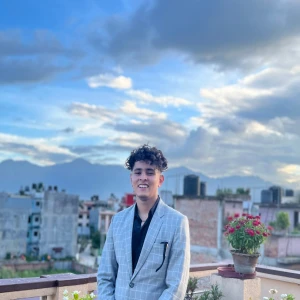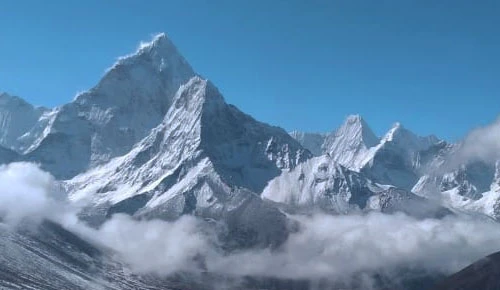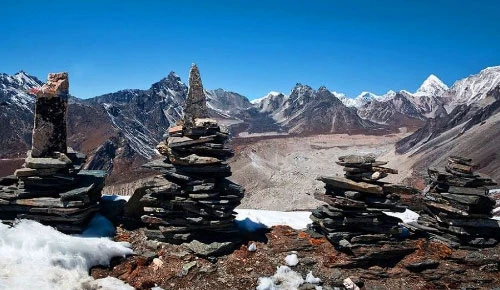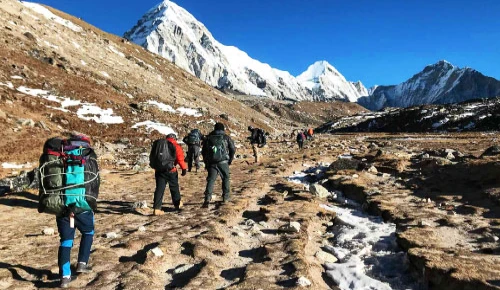12 Major Monasteries in Everest Region, Nepal
Nestled within the towering peaks of the Himalayas lies the awe-inspiring Everest region, a place that boasts not only the world's highest mountain but also a rich tapestry of culture and spirituality. Here, the Sherpa people, known for their indomitable spirit and close connection to Buddhism, have thrived for centuries. This region, often referred to as "the land of Mount Everest," is not just a geographical wonder but a repository of profound religious significance.
Everest is also the home of the Sherpa people, who had a strong influence from Buddhism before it became known as the Everest Region, "the land of Mount Everest." Sherpa people were the natives of eastern Tibet before it was a secular country. Later, they moved to the Khumbu region, which is known as the southern entrance to Mount Everest.
The Khumbu area is famous for its precious mountain scenery, including Mount Everest, the tallest mountain in the world. So many travelers dream of Everest Base Camp as their lifetime achievement. Along with its natural beauty, the area is home to several monasteries that are important to the Sherpa people who live there and to trekkers who come to see them.
In addition to being important religious sites, these monasteries are also significant cultural icons and havens for both residents and tourists. The following are a few well-known monasteries in the Everest region.
Table of Contents
Rongbuk Monastery
Rongbuk Monastery, which is also referred to as Rongphu Monastery, is not in Nepal's Everest Region. Instead, it is in China, on the northern side of Mount Everest (known as Qomolangma in Tibetan), in the Tibet Autonomous Region. It stands about 5,100 meters (16,732 feet) above sea level and is thought to be one of the tallest religious sites in the world. Rongbuk Monastery is famous for its beautiful setting and for being a base camp for mountain climbers trying to reach the top of Mount Everest from the northern Tibetan side. It is about 20 kilometers (12 miles) from Everest Base Camp on the Tibetan side.

For both Tibetan Buddhists and mountain climbers, Rongbuk Monastery is a very important place of worship. Before going on a trek or climbing in the area, pilgrims go to the monastery to pray and ask for benefits.
Thaktul Monastery
The Thaktul Monastery is a Buddhist monastery in Thak Khola Valley. The monastery is one of the oldest and most important in the area. It is a UNESCO World Heritage Site. The Malla king asked a Tibetan monk named Lama Sangye Gyaltsen to help spread Buddhism in Nepal, so he founded the monastery in the 1400s. The monastery is on top of a hill with a view of the Thak Khola valley.
There is a major monastery, a library, and several smaller shrines in this group of buildings. The main monastery is for the Buddha and has paintings and figures all over it. There are many Buddhist books and objects in the library. Pilgrims and tourists alike love to visit the monastery. It's a calm and peaceful spot to learn about Buddhism and Nepali culture.
Thame Monastery
Thame Monastery is situated in the village of Thame. The village is located to the west of Namche Bazaar. The affiliation of the organization is with the Nyingma sect of Tibetan Buddhism. The monastery is highly significant in Sherpa culture due to its preservation of traditional rituals and ceremonies. One of the notable attractions for trekking to Gokyo Lake or those heading to Base Camp is Thame Monastery.

The Thame Monastery is not only a place of worship but also a place where people can learn about and practice their religion. Every day, the monks at the abbey do routines, pray, and meditate. People can visit the monastery and enjoy its peaceful and reflective atmosphere. Sometimes they can even join in on prayer sessions.
Pema Namding Monastery
Ngawang Jigdral Rinpoche, who is also the Head Lama, built the Buddhist monastery. Trulsik Rinpoche of Thupten Chholing Monastery was responsible for giving the monastery its name.

Pema Namding Monastery is still pretty new, but it has already become a famous place for both monks and tourists. People love the abbey for its peaceful atmosphere, beautiful buildings, and stunning views of the mountains nearby.
There are also many important Buddhist items on the sacred site, such as a figure of the Buddha that is thought to be over 1,000 years old. People of all religions can visit Pema Namding Monastery to learn about Buddhism, relax, or just enjoy the peace and beauty of the area.
Drepung Monastery
Jamyang Choge Tashi Palden (1397–1449), one of Tsongkhapa's most important followers, opened Drepung Monastery in 1416. It was named after Shridhanyakataka, a holy place in South India. The Gelugpa school was based in Drepung, which was also the most important of the four great Gelugpa holy sites. Before the Great Fifth Dalai Lama built the Potala, the Ganden Phodrang (dga' ldan pho brang) in Drepung was where the Dalai Lamas lived. It was said that Drepung was like Nalanda in India, which is a great Buddhist monastery university. It was known for having very high academic standards.
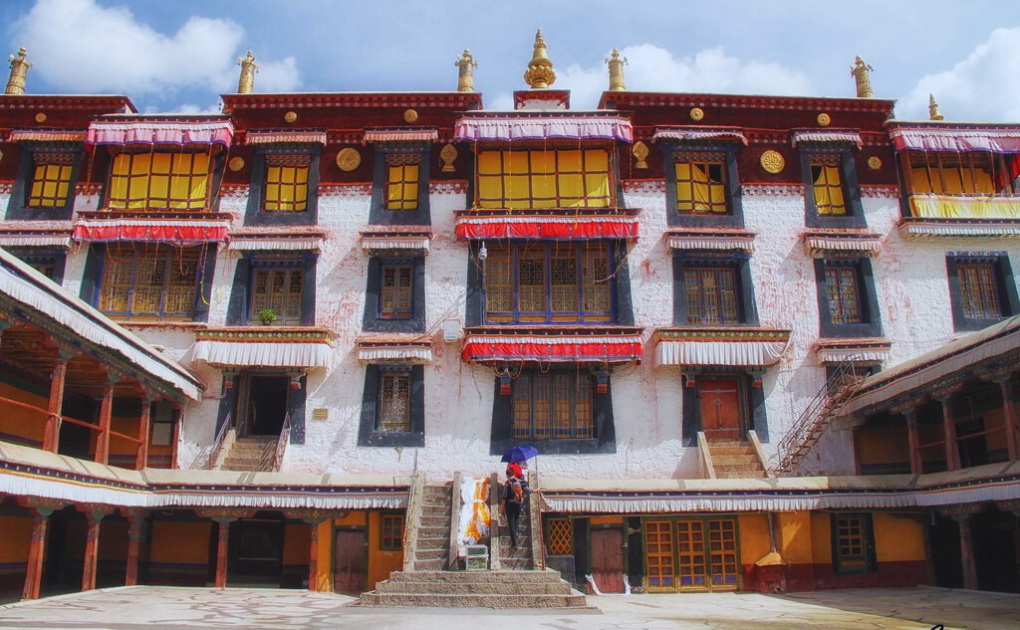
Drepung Monastery is still a busy place where Buddhists come to learn and practice. Over 10,000 monks and students from all over the world live there. There are many classes at the school, such as standard Buddhist studies, meditation, and Tibetan language and culture.
Namche Monastery or Tengboche Monastery
Namche Monastery, also called Namche Bazaar Monastery or Tengboche Monastery, is a Buddhist monastery in the town of Namche Bazaar in Nepal's Everest Region. Namche Bazaar is a major trade and government center. Trekkers and travelers often stop in this town on their way to Base Camp or other high-altitude sites in the area to get used to the air. Along with "Namche Monastery" or "Tengboche Monastery," the holy site in Namche Bazaar is linked to the famous Tengboche Monastery.

Within the 1600s, Lama Sangje Tenzing started a monastery. Numerous important Buddhist relics, including a Buddha figure thought to be more than 1,000 years old, can be found there. It is a center of Sherpa Buddhism.
An increasing number of visitors and tourists are visiting the monastery, which mentions that the Tenbogche Trek is also a great destination for those trekkers who want to escape the base camp trek. Finding out about Buddhism and Sherpa culture in this calm and peaceful spot is an opportunity.
Mende Monastery
Lama Zopa Rinpoche, who was a well-known Nyingma guru at the time, established the monastery in the 17th century. It rapidly developed into a hub for Buddhist study and practice, a position it still holds to this day. Over one hundred monks and students from various parts of the globe call the monastery their home.
The Mende Monastery is a popular location for travelers of all stripes, including pilgrims. An education in Buddhism and Nepalese culture may be had here in an environment that is calm and quiet. In addition, the monastery makes for an excellent home base for outdoor activities such as climbing and trekking in the Solukhumbu area.
Thamo Monastery
Thamo Monastery is a Buddhist monastery located in the Everest Region of Nepal. Situated near Namche Bazaar, it serves as a spiritual center for the local Sherpa community and trekkers. Thamo Monastery offers a tranquil environment for meditation and religious practice, and it often welcomes visitors interested in experiencing the Tibetan Buddhist culture and rituals. The monastery's architecture and mountain surroundings make it a peaceful and scenic place for reflection and exploration in the Himalayas.

Khumjung Monastery
Khumjung Monastery is a well-known Tibetan Buddhist monastery that can be found in the town of Khumjung, which is situated in the Khumbu Region of Nepal. It is a component of the Khumbu area, which is well-known for the breathtaking alpine scenery it contains, including Mount Everest. The Khumjung Monastery is a Tibetan Buddhist institution that is associated with the Nyingma school of Buddhism. It is also well-known in the area for its cultural and spiritual importance. Guests that come to the monastery have the opportunity to see ancient rites, wander around the peaceful surroundings, and gain knowledge about Sherpa culture as well as Tibetan Buddhist traditions.

Pangboche Monastery
Pangboche Monastery, nestled in the Everest Region of Nepal, is a centuries-old Tibetan Buddhist monastery. Situated at an elevation of approximately 3,985 meters (13,074 feet), it's one of the highest monasteries in the region. Pangboche Monastery is renowned for its rich history, intricate murals, and cultural significance. It houses sacred relics, including what's believed to be a Yeti scalp, adding an element of intrigue. Trekkers en route to Base Camp often stop at Pangboche to explore its spiritual ambiance and take in panoramic mountain views. The monastery's location amidst the Himalayas creates a spiritually inspiring and visually captivating experience.
Phakding Monastery
Phakding Monastery, also known as Rimijung Monastery, is a little but culturally important Buddhist monastery that can be found tucked away in the town of Phakding, which can be found in the Solukhumbu district of Nepal. This settlement is located along the famous trekking path that leads to Base Camp. Phakding Monastery is often one of the first monasteries that hikers come across on their way to Base Camp because of its location at a comparatively low height of around 2,610 meters (8,563 feet).
This monastery is part of the Nyingma school of Tibetan Buddhism, which is known for its peaceful atmosphere and kind welcome. Trekkers are offered a tranquil retreat here as well as an insight into Buddhist rituals and native Sherpa culture. The monastery is adorned with many items of religious significance, such as prayer wheels, colorful prayer flags, and antiquities. The resident monks will let visitors participate in their daily rituals, and visitors will also have the opportunity to join in on their meditation sessions.
Kyarok Monastery
This is Kyarok Monastery, which is also called Sangngag Choling Monastery. It is a Nyingma Tibetan Buddhist monastery in Nepal's Khumbu area. It is in the town of Kyarok, which is about 15 kilometers from Namche Bazaar and is 3,623 meters (11,886 feet) above sea level.
This is Kyarok Monastery, which is also called Sangngag Choling Monastery. It is a Nyingma Tibetan Buddhist monastery in Nepal's Khumbu area. It is in the town of Kyarok, which is about 15 kilometers from Namche Bazaar and is 3,623 meters (11,886 feet) above sea level.
Conclusion
In conclusion, the Everest region is a place of unparalleled beauty and cultural significance. The monasteries, such as Tengboche, Pangboche, Thame, Namche, and Phakding, stand as monuments of Tibetan Buddhism and provide a profound opportunity for trekkers and visitors to immerse themselves in the region's rich culture, meditate, and reflect on their own spirituality amidst the stunning Himalayan backdrop.
Whether you seek to experience the spiritual energy of a remote high-altitude sanctuary or wish to delve into the area's cultural tapestry, these monasteries in the Everest Region open a window into the heart and soul of this extraordinary place. Through your visits to these sacred sites, you'll not only gain insights into the local people, their customs, and the natural beauty that envelops the region, but you'll also forge a deep connection with a place that is undeniably captivating for both trekkers and those with a thirst for cultural exploration.
As you plan your journey to the Everest Region, consider exploring the various options available, whether it be embarking on a trekking adventure or opting for a helicopter tour. To make your travel arrangements, reach out to local tour operators and agencies specializing in organizing trips to this remarkable corner of the world. Your exploration of the Everest Region promises to be a truly transformative experience amidst the awe-inspiring Himalayan landscapes.
Booking Options
For those looking to explore the Everest Region, there are two main options for reaching these enchanting monasteries. You can opt for traditional trekking to Everest region, which allows you to fully absorb the stunning landscapes and interact with the local communities along the way. Alternatively, if you prefer a faster and more convenient way to access these cultural gems, helicopter tour to Everest are also available. To book either a trek or a helicopter tour, you can contact local tour operators and agencies that specialize in organizing trips to this remarkable region. They will assist you in planning your journey and ensuring a memorable experience amidst the majestic Himalayas.




